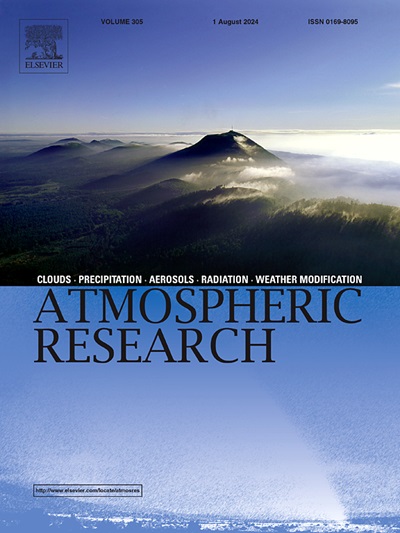PreciDBPN: A customized deep learning approach for hourly precipitation downscaling in eastern China
IF 4.5
2区 地球科学
Q1 METEOROLOGY & ATMOSPHERIC SCIENCES
引用次数: 0
Abstract
Long-term series of high-resolution gridded precipitation datasets are essential for hydrological and meteorological research. Producing high-resolution precipitation data from regional models demands substantial computational resources and labor. Global Reanalyses offer long-term coverage and effectively capture annual and seasonal precipitation patterns. However, they have inadequate resolution and frequently have difficulties depicting extreme conditions. This study proposes an efficient and accurate approach for generating long-term series of high spatial and temporal resolution precipitation. It is achieved by leveraging deep learning techniques to integrate the fifth generation of the European Centre for Medium-Range Weather Forecasts (ECMWF) global climate reanalysis (ERA5, 0.25°, hourly) data with high-resolution precipitation fusion datasets. Considering the heavy-tailed distribution of precipitation, we developed the PreciDBPN model structure, which combines a classification network with a super-resolution network and incorporates physically relevant indices into the model's input. We trained and evaluated the PreciDBPN and baseline models in eastern China using the China Meteorological Administration Land Data Assimilation System (CLDAS) precipitation dataset (0.0625°, hourly, 2017–2022). When compared to baseline methods and ERA5, our model excels in multiple metrics and provides a more precise representation of relative rainfall frequency. Independent verification was performed using station observations during the period of 2010–2015 when CLDAS data were unavailable. During this verification, the PreciDBPN demonstrated exceptional performance and greater robustness compared to the baseline models. Because our method can efficiently downscale precipitation and bias-correct reanalysis data using minimal computational resources, it can be used to generate high-resolution precipitation datasets (0.0625°, hourly) from 1979 to 2022 while correcting for heavy precipitation underestimations in reanalysis data.
PreciDBPN:中国东部降水小时降尺度的定制化深度学习方法
长期系列的高分辨率网格降水数据集对水文和气象研究至关重要。从区域模式中生成高分辨率降水数据需要大量的计算资源和人力。全球再分析可提供长期覆盖范围,并有效捕捉年度和季节降水模式。然而,它们的分辨率不足,经常难以描绘极端条件。本研究提出了一种高效、准确的方法,用于生成高时空分辨率降水的长期序列。该方法利用深度学习技术,将欧洲中期天气预报中心(ECMWF)第五代全球气候再分析(ERA5,0.25°,每小时)数据与高分辨率降水融合数据集整合在一起。考虑到降水的重尾分布,我们开发了 PreciDBPN 模型结构,它将分类网络与超分辨率网络相结合,并将物理相关指数纳入模型输入。我们利用中国气象局陆地数据同化系统(CLDAS)降水数据集(0.0625°,每小时,2017-2022年)在中国东部对PreciDBPN和基线模式进行了训练和评估。与基线方法和ERA5相比,我们的模型在多个指标上都更胜一筹,并能更精确地表示相对降雨频率。在 2010-2015 年期间,由于 CLDAS 数据不可用,我们使用观测站观测数据进行了独立验证。在验证过程中,与基线模型相比,PreciDBPN 表现出了卓越的性能和更强的鲁棒性。由于我们的方法可以利用最少的计算资源有效地降低降水尺度并对再分析数据进行偏差校正,因此可用于生成从 1979 年到 2022 年的高分辨率降水数据集(0.0625°,每小时),同时校正再分析数据中被低估的强降水。
本文章由计算机程序翻译,如有差异,请以英文原文为准。
求助全文
约1分钟内获得全文
求助全文
来源期刊

Atmospheric Research
地学-气象与大气科学
CiteScore
9.40
自引率
10.90%
发文量
460
审稿时长
47 days
期刊介绍:
The journal publishes scientific papers (research papers, review articles, letters and notes) dealing with the part of the atmosphere where meteorological events occur. Attention is given to all processes extending from the earth surface to the tropopause, but special emphasis continues to be devoted to the physics of clouds, mesoscale meteorology and air pollution, i.e. atmospheric aerosols; microphysical processes; cloud dynamics and thermodynamics; numerical simulation, climatology, climate change and weather modification.
 求助内容:
求助内容: 应助结果提醒方式:
应助结果提醒方式:


